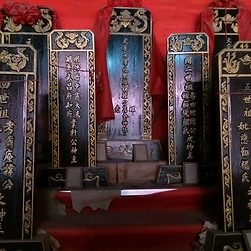Website Project

Introduction to Chinese Ancestral Worship
Li Ting Ng

Abstract
Chinese ancestral worship is an integral part of Chinese society, and is conducted during anniversaries, or traditional festivals and holidays. This practice shows the significance of Filial Piety and the respect towards elders and ancestors in Chinese culture. Specific traditions have evolved over time and been adapted throughout regions. However, there are still common features including the use of ancestral tablets, the offering of food and drinks, and some form of prayer or behavioral custom. Modern adaptations of ancestral worship are also increasingly varied, due to the migration of Chinese communities around the world and the introduction of non-traditional practices.
History and Background
This section briefly outlines some key developments in Chinese ancestral worship since the origins of China. It shows the progression of burial and worshipping practices throughout the history of China, and how worshipped practices have always been complex and tied to cultural values.
Changes throughout periods
8000 BCE - 2000 BCE
Neolithic period in China
5000 BCE - 3000 BCE
Yangshao period
Neolithic Chinese people had already invested much effort into burying their dead and maintaining them after their passing.
Religious practices and oracle bone divination were carried out during worships to communicate with the dead.
Tombs, coffins, and artifacts also showed the reverence towards ancestors in this period (Lakos 2010, 13).
Village cemeteries were prevalent in this period.
Collective secondary burial, which involves the reburial of human remains, thrived.
2000 BCE- 1900 CE
Chinese Dynasties
People of the earlier dynasties beginning with the Shang put in tremendous effort into the construction of lavish ancestral tombs, and coffins were surrounded with precious ornaments and essential items.
Up to eighteen kinds of offerings were made each year during worships in the Shang Dynasty (Lakos 2010, 18).
In the later dynasties, religions and beliefs like Buddhism, Daoism, and Confucianism became intertwined with worshipping practices (Lakos 2010, 23).
Filial Piety
Essential Elements of
Ancestral Worship
These elements can usually be found at most traditional ancestral worships, during special dates such as anniversaries, festivals, or when a new family member is born.

Location of Worship
Gravesites of ancestors are visited during worshipping sessions as it offers a physical connection between the worshippers and their ancestors.

Tablets
Tablets might be found both at home or at sites of worship, and incense is burnt at ancestral tablets to express gratitude towards or pay respects to the ancestors (Hu 2016, 173).

Genealogy
The genealogy book of the family records members who are considered part of the family. When a new birth happens, the newborn's name will be added to the records (Hu 2016, 173).
Offerings
Traditions and Rituals
Folkgroups choose traditions from their past which give their group a sense of identity and reinforces values that still match with the group's present conception (Sims and Stephens 2011, 71).
While filial piety has evolved in the modern age, many Chinese still respect their ancestors as family is still an integral part of Chinese culture. As a result, many of these ancestral worship rituals are still practiced today.

The Spiritual Aspect of Worship
A segment of worshippers believe that the spirits of ancestors are present around them and the worshipping of ancestors creates a form of communication to these spirits (Hu 2016, 178-180).
At these worshipping sessions, people might pray to their ancestors to grant their wishes, or to pray for loved ones to recover from their illnesses.
Traditionally, worships are also conducted to pray for rain during dry seasons and during periods before the harvesting of crops. Today, people might pray for prosperity and success
How ancestors might grant luck
There is no real basis or evidence that praying to ancestors for the granting of wishes would work. However, as seen in how 'luck' is commonly found in many folk traditions, this too plays a role in ancestral worship.
For example, Japanese scientists and researchers take part in similar worship sessions to show gratitude to dead experimental animals as part of a memorial service (Powell, 2017).
Individuals in other fields such as archaeology and astronomy also use totems and rituals to pray for success in their work (Powell, 2017).
While these practices are not grounded in science, they do provide something extra outside of rational practices that might result in miracles.
Stories and folklore resulting from these occurrences then add on to the lore and magic around ancestral worship, and deepens the traditions involved (Sims and Stephens 2011, 70).
Conclusion and
Modern Adaptations
Chinese ancestral worship is still relevant in the modern day, not just because of its connections to the past, but because the practice reinforces social values and relationships that are still important in the lives of Chinese people today (Lakos 2010, 3).
With globalization and the changes in practices due to modern life, some quirky or non-traditional practices have become a part of some worshipping sessions (Yao 2018).
What do you think of some of these additions?
Bibliography
1 /
Hu, Anning. 2016. “Ancestor Worship in Contemporary China: An Empirical Investigation.” China Review 16(1): 169-186. JSTOR.
2 /
Lakos, William. 2010. Chinese Ancestor Worship: A Practice and Ritual Oriented Approach to Understanding Chinese Culture. Newcastle upon Tyne: Cambridge Scholars Publishing.
3 /
Powell, Kendall. 2017. "Behavior: A Lookout For Luck." Nature 551: 261-263. Nature.
4 /
Sims, Martha, and Martine Stephens. 2011. Living Folklore, 2nd Edition: An Introduction to the Study of People and Their Traditions. Logan, Utah: Utah State University Press.
5 /
Yao, Jiaying. 2018. "How Much Do Foreigners Know About This Ancient Chinese Festival For the Dead?" Global Times Metro Shanghai. Gale OneFile.






